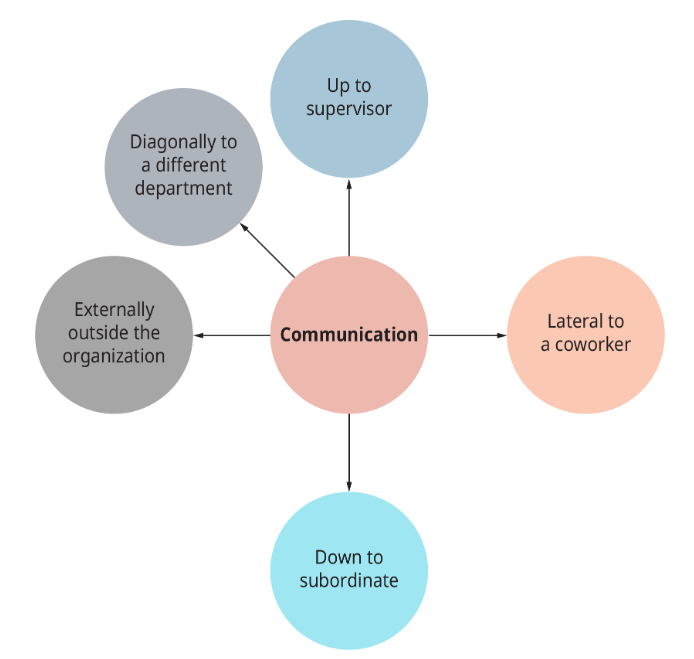10.2 Organizational Communication
Within organizations, communication is used widely throughout the organizational structure. To achieve effective communication, the sender’s message is fully interpreted and understood by the receiver. When communication is effective, it provides the receiver the ability to understand what is said and either act, or provide a concise response to the sender, engaging in effective conversation. Effective conversation is best when the communication can be delivered at minimal cost of resources, which is referred to as efficient communication. Efficient communication is when a manager tells an employee something, using jargon or colloquialisms, and the employee understands completely and then carries out a task. On the other hand, the use of jargon and colloquialisms might not be the best way to foster efficient communication if the employee does not understand them/ This means that leaders and managers have to be flexible with the language they use in order to foster efficient communication with all members inside the organization.
There are many ways effective and efficient communication can be relayed. One of the most common is oral communication, which is the exchange of messages that are spoken and understood[4]. With oral communication being quite common, spoken messages go hand-in-hand with listening. Listening, in many ways, is receiving the message from the sender. However, in organizations, the goal is to achieve the process by taking action to help someone say what is actually meant. This is referred to as active listening. Active listening is important to understanding and interpreting the message by creating an effective action with the communication presented. There are rules to active listening that must be followed when receiving a message:
- listen for the message transmission
- listen for feelings
- acknowledge all cues
- paraphrase and restate
Following these rules allows the receiver to fully understand the content being presented. Active listening is especially important in organizations where learning is being fostered, given that learners learn at different rates and levels. Effective communication and active listening are vital to transmit learning to all levels of students. For example, teachers who use oral communication need to be effective in their transmissions, so that students who are actively listening can relay back and restate the ideas presented. Teachers in classrooms are leaders, and if students cannot comprehend the messages, teachers may have to refine their oral communication to allow for active listening to be present.
What if oral communication doesn’t work? There are other forms of communication that allow learners to become active listeners. Written communication includes email messages, texts, reports, and other annotations relayed from messenger to receiver for precise information[4]. When something particular needs to be mentioned, or a set of specific steps need to be followed, the use of written communication can be effective in relaying the exact steps. The active listening of written communication is the following of the detailed instructions. For example, the teacher might say, “The final assignment should be at least seven pages”. One student may interpret that as seven pages in any format, whereas another student may not feel “seven pages” provides enough information, and might ask for more detailed guidelines. The teacher then may provide a specific rubric that states that the final assignment must be a minimum of 1,700 words, double-spaced, in the size 12 Times New Roman font. This is the precise information that is needed, in many instances, to provide a more complete interpretation of the information being transmitted.
There is another form of communication that does not incorporate reading or writing: nonverbal communication [4]. The use of physical examples, such as eye movement and hand gestures, or environmental examples, such as using a turn signal in a car, or even a billboard are some forms of nonverbal communication. For example, if communication cannot be transmitted through oral or written communication, a they might use images or hand gestures to illustrate their points. This heightens two senses in the students because they need to use their ears and eyes to accept and understand the information from the teacher. Nonverbal communication transmission can be effective for many individuals, but problems can appear in environmental examples, which segways into connecting communication with social influences.
Communication, either oral, written or nonverbal, is a social process[4]. Figure 2 outlines the many social influences that are present within an organization, which can be mirrored in an organization of learning:

One communication component that is prevalent in learning organizations is the concept of feedback and ensuring that learning is happening with the student present. Feedback is the process of verifying information or the reaction about a product or process, which attempts to foster improvement. With learning, it is important to give learners feedback to ensure that they are progressing through higher-order levels of learning. Teachers need to go one step further, however, and ensure that the feedback is useful and the student is progressing. This is called constructive feedback and it ensures that someone is being provided a path for improvement. Here are some guidelines to ensure that feedback is constructive:
- provide direct feedback based on trust
- ensure feedback is specific
- ensure feedback is valid
- give feedback in small doses
All these forms, within learning organizations, help build the communication process through better understanding and conceptualization. It is clear that communication takes many forms, and that some are more relevant to the situation than others.
<<Why you think you’re right; even if you’re wrong – Julia Galef>>
When a manager tells an employee something using jargon or colloquialisms, the employee understands completely and carries out a task
The exchange of messages that are spoken and listened
Transmitting the message from the sender, and taking action to help someone say what they actually mean
The use of emails, texts, reports and other annotations relayed from messenger to receiver for precise information
The transmission of communication without reading or writing
Ensuring feedback is useful and following up on the feedback to ensure the learner is progressing

